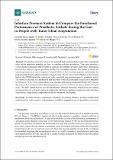Interface Pressure System to Compare the Functional Performance of Prosthetic Sockets during the Gait in People with Trans-Tibial Amputation
Author(s)
Huegel, Joel C.
Downloadsensors-20-07043.pdf (4.072Mb)
Publisher with Creative Commons License
Publisher with Creative Commons License
Creative Commons Attribution
Terms of use
Metadata
Show full item recordAbstract
The interface pressure between the residual limb and prosthetic socket has a significant effect on the amputee’s mobility and level of comfort with their prosthesis. This paper presents a socket interface pressure (SIFP) system to compare the interface pressure differences during gait between two different types of prosthetic sockets for a transtibial amputee. The system evaluates the interface pressure in six critical regions of interest (CROI) of the lower limb amputee and identifies the peak pressures during certain moments of the gait cycle. The six sensors were attached to the residual limb in the CROIs before the participant with transtibial amputation donned a prosthetic socket. The interface pressure was monitored and recorded while the participant walked on a treadmill for 10 min at 1.4 m/s. The results show peak pressure differences of almost 0.22 kgf/cm<inline-formula><math display="inline"><semantics><msup><mrow></mrow><mn>2</mn></msup></semantics></math></inline-formula> between the sockets. It was observed that the peak pressure occurred at 50% of the stance phase of the gait cycle. This SIFP system may be used by prosthetists, physical therapists, amputation care centers, and researchers, as well as government and private regulators requiring comparison and evaluation of prosthetic components, components under development, and testing.
Date issued
2020-12-09Department
Massachusetts Institute of Technology. Center for Extreme BionicsJournal
Sensors
Publisher
Multidisciplinary Digital Publishing Institute
Citation
Aguila, Ibarra et al. “Interface Pressure System to Compare the Functional Performance of Prosthetic Sockets during the Gait in People with Trans-Tibial Amputation.” Sensors, 20, 24 (December 2020): 7043 © 2020 The Author(s)
Version: Final published version
ISSN
0746-9462